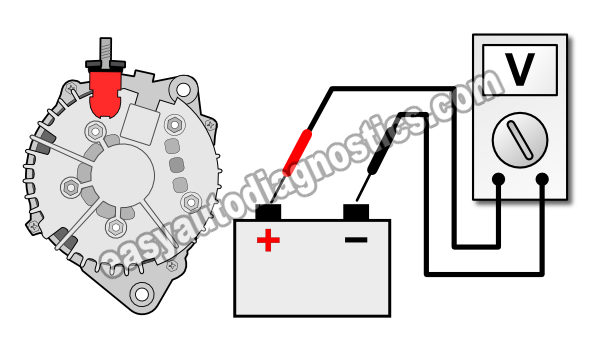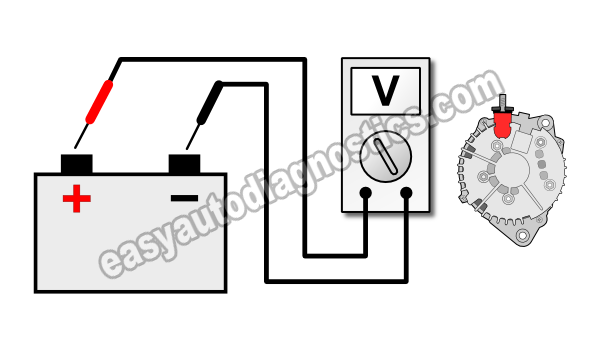
In this tutorial, I'm gonna' show you how to test the alternator, on your 2002-2006 2.5L Altima with just a multimeter.
All of the test steps are explained in a step-by-step way and by the end of the tests, you'll be able to say that, 'Yes, my alternator is bad' or 'No, the alternator is doing its job'.
Contents of this tutorial:
Symptoms Of A Bad Alternator
As you're already aware, the alternator's job is to basically maintain the battery at its full potential (so that you can crank and start the engine) and to provide all of the electrical current your Nissan's electrical accessories need (once the engine has started and is running).
These electrical accessories include, but not limited to: the fuel pump, the ignition coils, the radio, the windshield wipers, the AC compressor, and the list goes on...
So, when the alternator fails in your Nissan Altima, you'll notice one or several of the following symptoms:
- The charge light (also known as the battery light) will be shining nice and bright on your Nissan's instrument cluster.
- Whenever you turn on the headlights (night driving), they glow very dim.
- The engine won't crank. It will only crank and start if you jump start it with another vehicle.
- The only way the car cranks and starts is if you charge the battery.
- The idle may get high when you come to a stop.
Thankfully, testing the alternator is not hard to do at all and in this tutorial, I'll show you how.
Where To Buy The Alternator And Save
The alternator, for the 2.5L Nissan doesn't come cheap. The links below will help you shop/compare and see where you can find the best deal on the alternator:
Disclosure: As an Amazon Associate, I earn from qualifying purchases. Buying through these links helps support this site at no extra cost to you. Thanks for your support —it really means a lot!
Not sure if the above alternator and alternator belt fit you particular 2.5L Altima? Don't worry, once you get to the site, they'll make sure the parts fit and if they don't they'll ask you about your Nissan's specifics to find you the right parts.
TEST 1: Battery Voltage Test With Engine Running

Alright, the very first test that you need to do, is to see what the battery's voltage is with the engine running with a multimeter.
If the alternator is working (and thus charging the battery), your multimeter should show a voltage around (or above) 13.5 Volts DC.
If the alternator is fried on your 2.5L Nissan Altima, then your multimeter will register a voltage around 12 Volts DC. This voltage will decrease the longer the engine runs.
NOTE: If the battery is completely dead in your Nissan, you'll need to charge it up. The battery must be charged enough to keep the vehicle running for at least 10 to 20 minutes.
These are the test steps:
- 1
Crank and start the engine and select Volts DC mode on your multimeter.
- 2
Probe the positive battery terminal with the red multimeter test lead.
With the black multimeter test lead, probe the negative battery terminal. - 3
Your multimeter is gonna' register one of two possible readings and they are:
1.) A steady 13.5 to 14.5 Volts DC.
2.) Or 12.5 Volts that will decrease the longer the engine stays running. - 4
Put an electrical load on the alternator to further confirm that it's either charging or not charging.
You can do this by turning on every accessory possible (inside the vehicle). For example: Turn on the A/C or heater on high, turn on the windshield wipers, turn on the headlights, turn on everything and anything that uses electricity inside and outside of the vehicle. - 5
Your multimeter will show you one of two things (as you turn on all of this stuff):
1.) The multimeter will register a nice and steady 13.5 to 14.5 Volts DC no matter what gets turned on or...
2.) It will register 12.5 V DC and this voltage will decrease more and more as you turn on stuff inside your Nissan.
OK, let's interpret your multimeter test results:
CASE 1: Your multimeter registered 13.5 to 14.5 Volts. This means that the alternator is charging the battery and thus it is not defective.
No further testing is required, since this multimeter test result eliminates the alternator on your 2.5L Altima as bad.
Now, if the battery is dead every morning, this tells you that you either have a bad battery or a parasitic drain. A parasitic drain is tech-speak for something staying on (usually inside the vehicle, for example: a dome-light) and draining the battery while the engine is off.
CASE 2: Your multimeter registered a voltage that steadily dropped down to 9 Volts. This is a clear indication that your Nissan's alternator IS NOT charging the battery.
Replacing the alternator at this point usually solves around 90% of the cases, but I suggest that you go on to TEST 2 just to make sure. Your next step should be: TEST 2: Checking The Continuity of the Bat (+) Cable.





